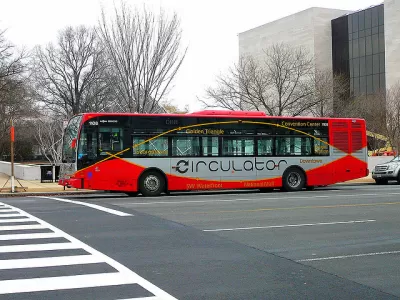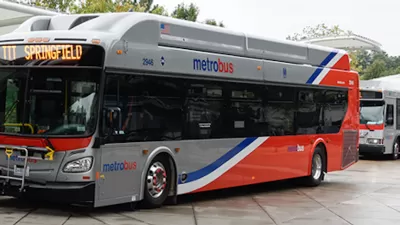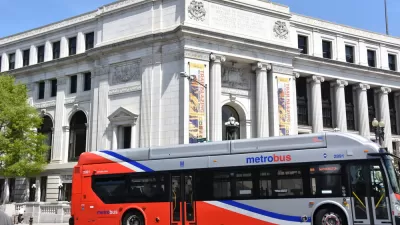The D.C. Circulator is struggling with maintenance costs and system performance. The balkanization of local bus systems in the region might be to blame.

Dan Malouf explains the effects of the balkanization, or fragmentation, of bus systems in the Washington, D.C. region.
So, there are "more than 20 separate bus providers in the Washington area. WMATA is the largest and covers the most territory, but most counties and large cities have their own," according to Malouf. "DC has Circulator, Montgomery has Ride On, Arlington has ART, etceteras."
It's the financial woes of the D.C. Circulator, reported by Martin Di Caro in May, that inspires Malouf's explanation. In fact, writes Malouf, the "situation suggests some of the thinking behind balkanization of the Washington region's bus network may be faulty."
The bulk of Malouf's analysis drills down on the inadequacies of how local bus operators measure the costs of operation. While the WMATA's Metrobus costs $142 per hour to operate, Fairfax County Connector runs at $104 an hour, ART runs at $72 an hour, and the DC Circulator runs at $83 an hour. However, as Malouf notes in detail, if the math looks too good to be true, it probably is.
FULL STORY: DC Circulator woes show why local buses can’t always replace Metrobus

Study: Maui’s Plan to Convert Vacation Rentals to Long-Term Housing Could Cause Nearly $1 Billion Economic Loss
The plan would reduce visitor accommodation by 25,% resulting in 1,900 jobs lost.

North Texas Transit Leaders Tout Benefits of TOD for Growing Region
At a summit focused on transit-oriented development, policymakers discussed how North Texas’ expanded light rail system can serve as a tool for economic growth.

Why Should We Subsidize Public Transportation?
Many public transit agencies face financial stress due to rising costs, declining fare revenue, and declining subsidies. Transit advocates must provide a strong business case for increasing public transit funding.

How to Make US Trains Faster
Changes to boarding platforms and a switch to electric trains could improve U.S. passenger rail service without the added cost of high-speed rail.

Columbia’s Revitalized ‘Loop’ Is a Hub for Local Entrepreneurs
A focus on small businesses is helping a commercial corridor in Columbia, Missouri thrive.

Invasive Insect Threatens Minnesota’s Ash Forests
The Emerald Ash Borer is a rapidly spreading invasive pest threatening Minnesota’s ash trees, and homeowners are encouraged to plant diverse replacement species, avoid moving ash firewood, and monitor for signs of infestation.
Urban Design for Planners 1: Software Tools
This six-course series explores essential urban design concepts using open source software and equips planners with the tools they need to participate fully in the urban design process.
Planning for Universal Design
Learn the tools for implementing Universal Design in planning regulations.
Ascent Environmental
Borough of Carlisle
Institute for Housing and Urban Development Studies (IHS)
City of Grandview
Harvard GSD Executive Education
Toledo-Lucas County Plan Commissions
Salt Lake City
NYU Wagner Graduate School of Public Service





























